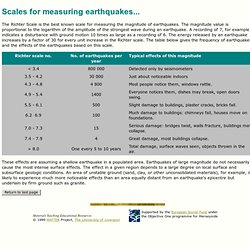

Richter scale. The Richter Scale is the best known scale for measuring the magnitude of earthquakes.

The magnitude value is proportional to the logarithm of the amplitude of the strongest wave during an earthquake. A recording of 7, for example, indicates a disturbance with ground motion 10 times as large as a recording of 6. Uffington White Horse. Coordinates: History[edit] The figure presumably dates to "the later prehistory", i.e. the Iron Age (800 BC–AD 100) or the late Bronze Age (1000–700 BC).

This view was generally held by scholars even before the 1990s, based on the similarity of the horse's design to comparable figures in Celtic art, and it was confirmed following a 1990 excavation led by Simon Palmer and David Miles of the Oxford Archaeological Unit, following which deposits of fine silt removed from the horse's 'beak' were scientifically dated to the late Bronze Age.[3] Searchable online world atlas - Times Atlases. Maps - National Geographic. Europe - Maps of European Countries, Capitals, Cities, Rivers and Lakes. Europe HistoryEurope was first inspired by the Classical Greek culture of the 8th-century B.C.It had a powerful influence on the Roman Empire that spread to Northern and Mediterranean Europe.

The Romans had a profound impact on the growth of rich culture and architecture. After the collapse of Roman Empire in the west, Byzantine Empire emerged and survived (285-1450) in the east. In Western Europe, several tribal groups assumed power, giving rise to small kingdoms. The geography of Western Europe went through a change.The Viking Age continued in Northern Europe from 8th to 13th centuries.The European colonial period, which spanned from the 16th to the mid-20th century, saw European powers establishing colonies in Asia, Africa, and the Americas.The European colonial era came to an end with revolts in Africa, India, and the Middle East.The two World Wars caused a severe damage to Europe both financially and demographically.
My Map. Geograph Britain and Ireland - photograph every grid square! Hide and Seek a Geocache > Geocache Gallery.